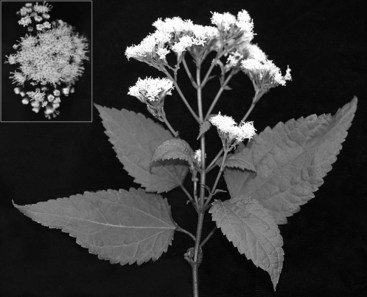White Snakeroot and Rayless Goldenrod Toxicosis
Basic Information 
Epidemiology
Species, Age, Sex
• All animals that graze on white snake root or rayless goldenrod are susceptible to the toxic effects of the plants.
• Lactating animals eating the plants secrete the toxin through their milk, thereby exposing their nursing young to the toxin.
• Humans drinking this milk will be similarly affected, developing “milk sickness.”
Risk Factors
• Poisoning by white snakeroot and rayless goldenrod is historically sporadic because of the considerable variation in the quantity of the tremetol present in the plants in different locations and growing conditions. Toxicity is highest in the green plant, but dried plants remain toxic. There are at least 26 species of Ageratina (Eupatorium) worldwide, and many are considered toxic. In the genus Isocoma, with 16 species, only three are reported to be toxic; I. pluriflora, I. tenuisectus, I. coronopifolia. However, all species should be considered toxic until proven otherwise.
• Animals eating 1% to 10% of their body weight of green white snakeroot can be fatally poisoned. Rayless goldenrod in the amount of 1% to 2% of body weight over a period of weeks can be lethal to horses.
Geography and Seasonality
• White snakeroot is a woodland plant of eastern North America extending as far west as North Dakota and south to Texas. It is an erect, branching, perennial plant growing 3 to 4 feet tall, with opposite, oval, pointed leaves with toothed edges. The flowers are small and white and are produced in flat-topped clusters at the ends of the branches (Figure 1).
• Rayless goldenrod, a common plant of the southwestern United States and northern Mexico, is a drought-tolerant perennial, growing 3 to 4 feet tall, with numerous, erect woody stems, and alternate, hairy, lanceolate, often resinous leaves. Yellow flowers are compact heads produced terminally. Seeds have a pappus of coarse whitish-brown bristles (Figure 2).
< div class='tao-gold-member'>
Stay updated, free articles. Join our Telegram channel

Full access? Get Clinical Tree



